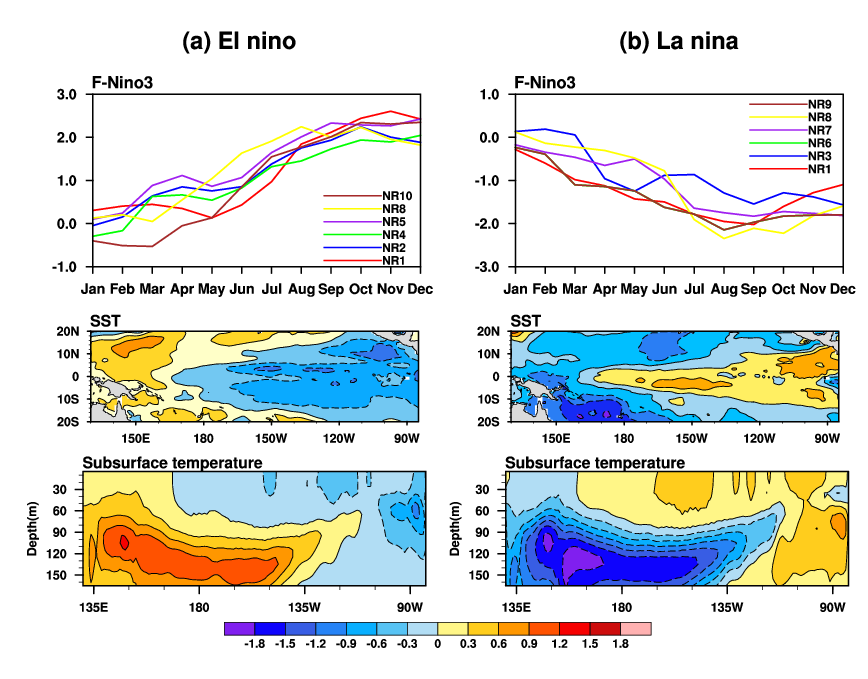State Key Laboratory of Numerical Modeling for Atmospheric Sciences and
Geophysical Fluid Dynamics (LASG)
Institute of Atmospheric Physics, Chinese Academy of Sciences

Vol. 2/No.2 April 2017
[Climate Predictability] Relationship between optimal precursory disturbances andoptimally growing initial errors associated with ENSO events:Implications to target observations for ENSO prediction
Since ENSO has a far-reaching impact on climate through teleconnections, accurate ENSO predictions are essential for producing meaningful seasonal climate predictions globally. However, considerable uncertainties still exist in real-time ENSO forecasting, especially those associated with poor predictive ability during the ENSOonset period. Therefore, exploring the precursory signals that precede the onset of ENSO events is very helpful to predict ENSO events with significant lead times.
Recently, Prof. DUAN Wansuo (LASG, IAP, CAS), together with his collaborators,revealed the optimal precursory disturbances of ENSO events that are most likely to trigger strong El Niño and La Niña events by superimposing initial sea temperature disturbances in neutral yearsusing an Earth System Model. They found that the optimal precursory disturbance for El Niño exhibits negative sea surface temperature anomalies (SSTAs) in the central-easternequatorial Pacific, and the subsurface temperature component exhibits negative anomalies in theupper layers of the eastern equatorial Pacific and positive anomalies in the lower layers of the westernequatorial Pacific; the optimal precursory disturbance for La Niña is almost opposite to that of El Niño (Figure 1).The evolutionary mechanisms of the optimal precursory disturbances are also addressed by tracking the time-dependentevolutions of SSTAs, sea surface wind anomalies and subsurface temperature anomalies. Both El Niño and La Niña originate from the precursory signals inthe subsurface layers of the western equatorial Pacific andtheir subsequent growth in the surface layers of the eastern equatorialPacific. Furthermore, they explore the relationship between the optimal precursory disturbances and the initial optimally growing initial errors associated with ENSO prediction that have been presented in previousstudies.They found that the optimal precursory disturbances for ENSO are particularly similar tothe optimally growing initial errors, which especially show that the optimal precursor source areas represent the sensitive areas for target observations associated with ENSO prediction. Combining the optimal precursory disturbances and the optimally growing initial errors for ENSO, they inferred that additional observations in thesesensitive areas can reduce initial errors and be used to detect precursory signals, thereby improving ENSOpredictions.
The paper has been published inJournal of Geophysical Research: Oceans in 2016.

Figure 1.The F-Niño3 indices, composite SSTAs and subsurface temperature anomalies of six precursory disturbances for (a) El Niño and (b) La Niña. These six precursory disturbances induce the strongest El Niño/La Niña events in the corresponding neutral years. The remaining four neutral years are not considered because few precursory disturbances occurred and the associated ENSO events were weak.
Citation:
Hu, J., and W. Duan (2016),Relationship between optimalprecursory disturbances and optimallygrowing initial errors associated withENSO events: Implications to targetobservations for ENSO prediction, J.Geophys. Res. Oceans, 121, 2901–2917,doi:10.1002/2015JC011386.
Contact: DUAN Wansuo, duanws@lasg.iap.ac.cn
E-mail: lasg_newsletter@lasg.iap.ac.cn
Editors: Chuanyi Wang (wangcy@lasg.iap.ac.cn), Kangjun Chen(ckj@lasg.iap.ac.cn)